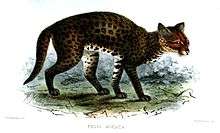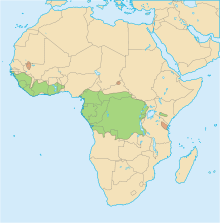African golden cat
| African golden cat | |
|---|---|
 | |
| Scientific classification | |
| Kingdom: | Animalia |
| Phylum: | Chordata |
| Class: | Mammalia |
| Order: | Carnivora |
| Family: | Felidae |
| Subfamily: | Felinae |
| Genus: | Caracal (Gray, 1843) |
| Species: | C. aurata |
| Binomial name | |
| Caracal aurata (Temminck, 1827) | |
| Subspecies | |
(but see text) | |
 | |
| Distribution of the African golden cat
Possible range or accidental records | |
| Synonyms | |
| |
The African golden cat (Caracal aurata) is a wild cat endemic to the rainforests of West and Central Africa. It is threatened due to deforestation and bushmeat hunting and listed as Vulnerable on the IUCN Red List.[1]
It is a close relative of both the caracal and the serval.[3] Previously, it was placed in the genus Profelis.[2]
Its body size ranges from 61 to 101 cm (24 to 40 in) with a 16 to 46 cm (6.3 to 18.1 in) long tail.[4]
Taxonomy and etymology
| |||||||||||||||||||||||||||||||||||||||
| The phylogenetic relationships of the African golden cat[5] |
The African golden cat is placed in the subfamily Felinae and the family Felidae. The species was first described by Dutch zoologist Coenraad Jacob Temminck on the basis of mounted cats from western Africa available for sale at a London museum. Temminck named a reddish-brown-colored skin with faint spots Felis aurata and a greyish skin F. celidogaster that was spotted all over with dark blotches and a red tail. Subsequently, a brownish grey skin from Sierra Leone was described as F. neglecta, a chestnut skin as F. rutilus, a dark grey skin as F. chrysothrix cottoni, and a black skin from Congo-Brazzaville as F. maka.[6][7]
The classification and phylogenetic relationships of the African golden cat has remained in dispute. It has historically been placed under Catopuma, Felis or Profelis.[2][8] However, studies in 2006 and 2009 have showed that the African golden cat has a particularly close relationship with the caracal (Caracal caracal). These two species, together with the serval (Leptailurus serval), form one of the eight lineages of Felidae. This lineage evolved nearly 8.5 Mya. More recently, the African golden cat has been considered a species of Caracal.[5][9] The African golden cat resembles the Asian golden cat, but are not closely related.[5]
Two subspecies are identified:[2][8]
- C. a. aurata Temminck, 1827 – Includes the allopatric populations.
- C. a. cottoni Lydekker, 1907 – Sometimes considered a semi-melanistic color morph because of the red or grey polymorphism and due to uncertainties about the type localities. Individuals resembling C. a. cottoni have been found all over the African golden cat's range in particularly humid habitats, and individuals in captivity have even been observed to change skin color between the typical red and dusky grey morphs as they shed their fur.[10]
Some works refer to C. a. celidogaster instead of C. a. cottoni, restricting the supposed C. a. aurata subspecies to the east of the Congo River, and C. a. celidogaster to the west of the Cross River, Gambia and Gabun.[10][11][12]
Characteristics
_fur_skins.jpg)
The African golden cat is about twice the size of a domestic cat. Its rounded head is very small in relation to its body size. It is a heavily built cat, with stocky, long legs, a relatively short tail, and large paws. Body length usually varies within the range 61 to 101 cm (24 to 40 in). Tail length ranges from 16 to 46 cm (6.3 to 18.1 in), and shoulder height is about 38 to 55 cm (15 to 22 in). The cat weighs around 5.5 to 16 kg (12 to 35 lb), with males being larger than females.[4][13]
The African golden cat has variable fur color, ranging from chestnut or reddish-brown, greyish brown to dark slaty. Some are spotted, with the spotting ranging from faded tan to heavy black in color. In others the spotting pattern is limited to the belly and inner legs. Its undersides and areas around the eyes, cheeks, chin, and throat are lighter in color to almost white. Its tail is darker on the top and either heavily banded, lightly banded, or plain, ending in a black tip. Cats in the western parts of its range tend to have heavier spotting than those in the eastern areas. Two color morphs, a red and a grey phase, were once thought to indicate separate species, rather than variations of the same species.[14] Melanistic individuals occur, but are not common.[15] Despite the wide variation in coat color, pelts of African golden cats can be identified by the presence of a distinctive whorled ridge of fur in front of the shoulders, where the hairs change direction.[4]
Overall, the African golden cat resembles the caracal, but has shorter untufted ears, a longer tail, and a shorter, more rounded face. They have small, rounded ears and eye colors that range from pale blue to brown.[16]
Distribution and habitat
The African golden cat inhabits tropical forests from sea level to 3,000 m (9,800 ft). It prefers dense, moist forest with heavy undergrowth, and is often found close to rivers, but it may also be found in cloud forest, bamboo forests, and high moorland habitats. The cat is found from Senegal in the west to Kenya in the east, and ranges as far north as the Central African Republic and as far south as northern Angola.[4]
Ecology and behavior
Due to its extremely reclusive habits, little is known about the behavior of African golden cats. They are solitary animals, and are normally crepuscular or nocturnal, although they have also been observed hunting during the day, depending on the availability of local prey.[4]
African golden cats are able to climb, but hunt primarily on the ground. They mainly feed on tree hyrax, rodents, but also hunt birds, small monkeys, duikers, young of giant forest hog, and small antelope. They have also been known to take domestic poultry and livestock.[4][14]
Reproduction
Knowledge of the African golden cat's reproductive habits is based on captive specimens. They breed readily in captivity. The mother gives birth to one or two kittens after a gestation period of around 75 days. The kittens weigh 180 to 235 g (6.3 to 8.3 oz), but grow and develop rapidly in comparison with other small cat species. One individual was reported to be scaling a 40-cm wall within 16 days of birth, reflecting a high degree of physical agility from an early age. The kittens' eyes open within a week of birth, and they are weaned at 6–8 weeks. Females reach sexual maturity at 11 months of age, but the males do not do so until 18 months.[4]
These cats live up to 12 years in captivity, but their lifespan in the wild is unknown.[4]

Threats
The African golden cat is threatened by extensive deforestation of tropical rainforests, their conversion to oil palm plantations coupled with mining activities and road building, thus destroying its essential habitat. It is also threatened by bushmeat hunting, particularly in the Congo Basin.[1]
Conservation
The African golden cat is listed in CITES Appendix II.[1] Hunting African golden cats is prohibited in Angola, Benin, Burkina Faso, Congo, Côte d'Ivoire, Democratic Republic of Congo, Ghana, Kenya, Liberia, Nigeria, Rwanda, and Sierra Leone. In Gabon, Liberia and Togo, hunting regulations are in place.[17]
References
- 1 2 3 4 Bahaa-el-din, L.; Mills, D.; Hunter, L. & Henschel, P. (2015). "Caracal aurata". IUCN Red List of Threatened Species. Version 2016.2. International Union for Conservation of Nature.
- 1 2 3 4 Wozencraft, W.C. (2005). "Order Carnivora". In Wilson, D.E.; Reeder, D.M. Mammal Species of the World: A Taxonomic and Geographic Reference (3rd ed.). Johns Hopkins University Press. p. 544. ISBN 978-0-8018-8221-0. OCLC 62265494.
- ↑ Johnson, W. E.; Eizirik, E.; Pecon-Slattery, J.; Murphy, W. J.; Antunes, A.; Teeling, E.; O’Brien, S. J. (2006). "The Late Miocene Radiation of Modern Felidae: A Genetic Assessment". Science. 311: 73–77. PMID 16400146. doi:10.1126/science.1122277.
- 1 2 3 4 5 6 7 8 Sunquist, M.; Sunquist, F. (2002). Wild Cats of the World. Chicago: University of Chicago Press. pp. 246–251. ISBN 0-226-77999-8.
- 1 2 3 Werdelin, L.; Yamaguchi, N.; Johnson, W.E.; O'Brien, S.J. (2010). "Phylogeny and evolution of cats (Felidae)". In Macdonald, D.W.; Loveridge, A.J. Biology and Conservation of Wild Felids (PDF). Oxford, UK: Oxford University Press. ISBN 978-0-19-923444-8.
- ↑ van Mensch, P.J.A.; van Bree, P.J.H. (1969). "On the African golden cat, Profelis aurata (Temminck, 1827)". Biologica Gabonica. V (4): 235–69.
- ↑ Wilson, D.E.; Reeder, D.M., eds. (2005). Mammal Species of the World: A Taxonomic and Geographic Reference (3rd ed.). Johns Hopkins University Press. p. 533. ISBN 978-0-8018-8221-0. OCLC 62265494.
- 1 2 Allen, G.M. (1939). "A checklist of African mammals". Bulletin of the Museum of Comparative Zoology. 83: 242.
- ↑ Johnson, W.E.; O'Brien, S.J. (1997). "Phylogenetic reconstruction of the Felidae using 16S rRNA and NADH-5 mitochondrial genes". Journal of Molecular Evolution. 44 Suppl. 1: S98–S116. PMID 9071018. doi:10.1007/PL00000060.
- 1 2 Pocock, R.I. (1907). "Notes upon some African species of the genus Felis, based upon specimens recently exhibited in the Society Gardens". Proceedings of the Zoological Society of London. 77 (3): 656–77. doi:10.1111/j.1469-7998.1907.tb06950.x.
- ↑ Mensch, P. J. A. v., Bree, P. J. H. v. (1969). On the African Golden Cat, Profelis aurata (Temminck, 1827). Biologia Gabonica V(4): 235–269.
- ↑ Butynski, T. M., Douglas-Dufresne, H., and de Jong, Y. A. (2012). Identification, distribution and conservation status of the African golden cat Caracal aurata in Kenya. Journal of East African Natural History 101(1): 3–16.
- ↑ Burnie, D, and Wilson, D. E. (Eds.) (2005). Animal: The Definitive Visual Guide to the World's Wildlife. DK Adult, ISBN 0789477645
- 1 2 Guggisberg, C. A. W. (1975). Wild Cats of the world. Taplinger Pub. Co., New York.
- ↑ AwwNews.com: African Golden Cat: Camera Traps Capture Stunning Photos of Africa’s Least-Known Felid. 24 August 2015. Retrieved 17 December 2015
- ↑ Macdonald, D. W. (2009). D. W. Macdonald, ed. The Princeton encyclopedia of mammals. Princeton, N. J.: Princeton University Press. p. 655. ISBN 978-0-691-14069-8.
- ↑ Nowell, K. and Jackson, P. (1996). Wild Cats: Status Survey and Conservation Action Plan. IUCN/SSC Cat Specialist Group, Gland, Switzerland.
External links
| Wikimedia Commons has media related to Profelis aurata. |
| Wikispecies has information related to: Profelis aurata |
- Species portrait African golden cat; IUCN/SSC Cat Specialist Group
- Rare African golden cat sightings
- Elusive golden cat caught on film in Uganda (black & white) (2009) and Gabon (colour) (2011)
